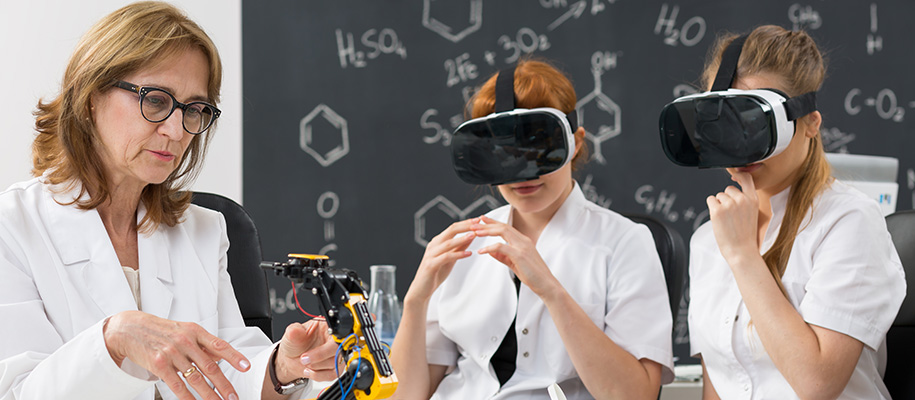When you think about science class, you probably imagine things like lectures, textbooks, labs, and worksheets. But thanks to game-changing technologies such as online collaboration boards, artificial intelligence (AI), and augmented reality (AR), STEM education is undergoing a digital makeover that's already transforming how today’s students learn.
This shift couldn't come at a better time. With STEM skills in high demand, science and math students need to prepare for tech-driven careers. Let’s take a look at how new technology is enhancing the STEM classroom experience and future opportunities for students.
The digital era calls for digitally powered learning
The writing is on the wall: Emerging technologies of today are disrupting industries across the board. According to the World Economic Forum’s Future of Jobs report from 2023, six out of the top 10 fastest-growing roles are related to technology, with over 75% of companies planning to adopt AI-powered technologies within the next five years. This means up to 44% of all workers will need new skills as job roles shift alongside automation. Adaptability will be key in the future job market.
As companies rapidly integrate new technologies to remain competitive, today’s STEM students should start building tech competencies to open doors to the most in-demand, future-proof careers. Educational experiences that are enhanced by technology offer the most ideal preparation going forward.
Collaborative innovation in digital learning and work
In recent years, online collaborative boards that promote cooperative learning in interactive virtual settings have emerged as essential tools to equip students for tech-infused workplaces. Multi-user digital platforms allow groups to innovate together in real time regardless of their location, with different formats enabling distinct collaborative experiences. For instance:
- Virtual whiteboards like Miro facilitate collective brainstorming, mind mapping, and the visualization of complex ideas. This ability to rapidly iterate on models and prototypes promotes creative thinking.
- Project management platforms like Asana provide transparency in coordinating team assignments. Features like task boards, calendars, and file sharing foster organized collaboration by tracking progress and delegating responsibilities.
- Collaborative coding environments like GitHub Classroom bring agile software teamwork to the classroom. Students can cooperatively write, run, and debug code without being physically together.
In fact, Dr. Yu-Cheng Tu and colleagues from the University of Auckland found that GitHub-based tools foster more teamwork and enable greater collaboration in their study, "GitHub in the Classroom: Lessons Learnt." According to them, these tools support teamwork and allow for "collaborative development of teaching material."
Related: How to Navigate Virtual Classrooms and Digital Learning as a Student
AI as your learning sidekick
Another big player in the digital learning game is the potential of AI. When used properly, AI can be your personalized STEM learning companion, providing unprecedented support in the classroom.
Laser-focused learning paths
One-size-fits-all curriculums are a thing of the past with AI—instead, your educational journey can be adapted to fit like a glove. In his study titled “An Integrative Review of AI-Powered STEM Education,” Dr. Jay Luzano states that algorithms can analyze your progress and abilities to serve up lessons precisely matched to your needs. Struggling with a difficult math concept like fractions? AI can provide you with specifically tailored materials such as practice problems with step-by-step explanations and solutions. If you start breezing through, you’ll advance to higher-level content more quickly.
On-demand expert guidance
Imagine having an Einstein-level tutor available 24/7 to explain difficult concepts. Well, according to Luzano, AI makes this a reality, offering the potential for step-by-step guidance at a moment’s notice. It can reinforce material through instant feedback and allow you to identify and correct knowledge gaps early on. Forget waiting until your next study session—with AI, the support you need is on demand, always.
New learning perspectives unlocked
AI isn't just an expert explainer; it can also be an innovative idea generator by uncovering hidden patterns and suggesting novel approaches to academics. Rapid virtual experimentation allows you to try creative techniques essentially hassle-free. Far from providing cut-and-dry answers, AI can nurture deeper learning that sticks with you.
Related: AI in the Classroom: Not a Replacement for Great Teachers
AR as your virtual laboratory
If AI is your digital tutor, then AR is your hands-on laboratory. “A Systematic Review of Augmented Reality in STEM Education” by Ajit, Lucas, and Kanyan in 2021 states that AR enables us to grasp even the most abstract concepts through immersive, interactive 3D visualizations. Students are no longer constrained by the physical world when they can don a virtual reality headset and dive into digital labs.
Digital experiments to explore
Why read about electrophoresis when you can separate DNA samples yourself with a simulation? AR allows you to perform experiments that are difficult to recreate in school science labs. This kind of firsthand experience could make a huge difference when it comes to landing a job after college.
Impossible destinations at your fingertips
Ever dreamed of touring the International Space Station or wandering through a rainforest ecosystem? AR field trips allow you to visit astonishing destinations you otherwise couldn’t and actively learn science in context. Moving educational experiences from textbooks to cutting-edge simulations makes them come alive.
Related: Beyond the Textbook: 4 Places to Look for Modern Academic Resources
How to maximize your STEM learning
As digital innovations transform STEM education, proactively sharpening your skills can help you maximize the potential benefits. Staying nimble and curious will help you pick up new technologies quickly. The pace of progress isn't slowing! Building digital literacy through introductory computer science and data analysis courses is key, as these will soon be universal foundations.
Work on developing your communication and collaboration through team projects that combine STEM and tech skills. But remember, you are using technology to strengthen and deepen core disciplinary knowledge, not replace it. Domain expertise has, and always will, remain crucial. Just take the research on pioneer programs adopting these platforms that highlights the pronounced benefits of integrated digital learning:
- Heightened engagement: The previously mentioned study by Ajit, Lucas, and Kanyan revealed that collaborative AR experiences boost student motivation by making content more interactive. Online boards magnify this as well, enabling cooperative learning and peer-to-peer social connections.
- Career-ready skills development: According to the World Economic Forum report, analytical and creative thinking reign supreme as the most coveted workplace skills. Collaborative boards provide fertile ground for exercising these skills through team innovation sprints.
- Preparation for remote work: With virtual work teams becoming commonplace, making sure students understand digital teamwork dynamics is essential. Online project management platforms provide valuable firsthand experience.
- Multimodal learning empowerment: Visual, verbal, and kinesthetic learners can employ their strengths when collaborating on boards. This flexibility can allow diverse learning styles to flourish.
- Authentic problem-solving: Educators can present real-world STEM challenges on digital platforms, motivating students to devise solutions together. It's an unparalleled way to link theory with practical application.
Real-world enhanced results
These innovations and their benefits aren't just theoretical—STEM programs are already demonstrating their advantages globally. Just consider these real-world examples:
- MATHia uses AI algorithms to offer over five million students personalized math instruction, yielding major testing gains.
- MEL Chemistry VR utilizes AR experiences to boost student mastery of molecular interactions and atomic structure.
- Online collaboration boards such as Slack and Asana enable remote STEM students to team up on projects and access community knowledge. U of Auckland found that using GitHub in computer science courses helped students gain experience with industry-standard tools and better prepared them for professional settings.
Related: A New Learning Ethos: What Does the Future of AI Look Like for Education?
Regardless of the platform, the message is clear: New tech solutions are here, and today's STEM students have a wealth of possibilities at their fingertips. While leveraging edtech to your advantage, remember that your natural curiosity and persistence remain your superpowers. The future depends on visionary young minds like yours; students who aren't afraid to ask questions and drive progress. Get out there and show the world how your generation can build a brighter tomorrow with science and technology!
Find out how Learner can help you with academics, and learn more about the digital shift with our three-part series on How AI Is Shaping the Workforce for New Graduates.









